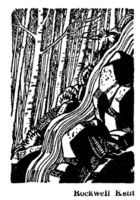October 1936 and February 1937 Issues of the New Masses
A Deeper Dive into Kent's works for the New Masses during the Great Depression
Kent was included in the New Masses’ October 20th issue from 1936. Unlike some of the other examples of his involvement, Kent’s contribution for this issue wasn’t the cover artwork but rather a smaller illustration for one of the inner sections. The section by James Hawthorne, titled “Stiffening the Militia,” revolves around the Spanish Civil War, detailing the author’s then recent experiences with the Republican side- those who fought against the overthrow of the country’s democratic republic. The writer describes how the disorganized and diverse collection of anti-fascists were bullied by the fascist rebels. The scattered loyalists were continuously forced to retreat, until one day when they unified into a competent army that was able to successfully fight back. Along with the article, Kent’s art shares the page with a Walt Whitman poem titled “Spain,” which the introduction says he personally picked out. The poem describes how, despite the fact that everything else is in ruin, Freedom- personified as the goddess Columbia-, remains unharmed and unwavering, inspiring the speaker to action with her permanence.
Using both texts, one is able to pick up a theme of democracy persevering through hardship, which is reflected in Kent’s artwork. With his classic black and white hatching style, Kent depicts a human head on a spike at a smoky battlefield (reminiscent of his work in the November 1927 issue, except that was depicting leftist martyrs). One can assume, based on the literary context and the Nazi swastika featured in the background, that the head is of a fascist. This reinforces the section’s showcasing of democracy prevailing and highlights the radicalness of Kent’s leftist politics, as a head on a stick is an extreme symbol.
Kent’s was also featured in the February 9th issue from 1937. This was also a smaller contribution- a tiny illustration for one of the articles: “Timberland Talks Turkey” by Irene Paull. The article discusses the striking of lumberjacks in Minnesota over their horrendous working conditions. It describes how they gained more faith in the political process to solve their grievances due to the state government’s support at the time. The author leaves the reader with the idea that the farm and labor movements must cooperate, specifically in Minnesota but eventually across the nation, to gain political power, as otherwise big business will defeat them. This idea is represented by Paull’s mention of the then popular third-party, the Minnesota Farmer-Labor Party, and how they should take the lead in the formation of a National Farmer-Labor Party.
Kent’s artwork for this section is uniquely ordinary compared to his other New Masses illustrations. In the same black and white, shadowy look of “Workers of the World Unite!,” Kent depicts a birch tree forest on the side of a hill. In front of the forest is a collection of rocks and shrubs, which is encasing a flowing stream. What makes it ordinary is that it's not a head on a spike or a fighting worker, but rather a mere nature scene. It’s almost reminiscent of Kent’s roots in landscapes. However, while just a simple nature illustration at first glance, the image takes on new meaning with the context of the article in which it’s embedded. On a very basic level, it shows the forest in which the lumberjacks work. However, one begins to think about the connotations of the forest and stream. For example, the stream could represent the progress of the lumberjacks in their movement, as the water runs on instead of remaining stagnant. Overall, Kent’s participation in this issue just further cements his leftist values and support for labor unions.
Part of 1 Learning Collection
<p>An In-Depth Explanation of Kent and His Beliefs<...
<p>Rockwell Kent's Unique Techniques Visualized in ...
<p>A Deeper Dive into Kent's works for the <i>New M...
<p>A Deeper Dive into the Beginning and End of the ...
Created For
K-12 EducatorK-12 Student
Museum Visitor
UMMA Docent
UMMA Staff
University Faculty
University Student
Rate this Resource
AVG: 0 | Ratings: 0
& Author Notes
All Rights ReservedLast Updated
December 2, 2023 7:05 p.m.Report
Reporting Policy


